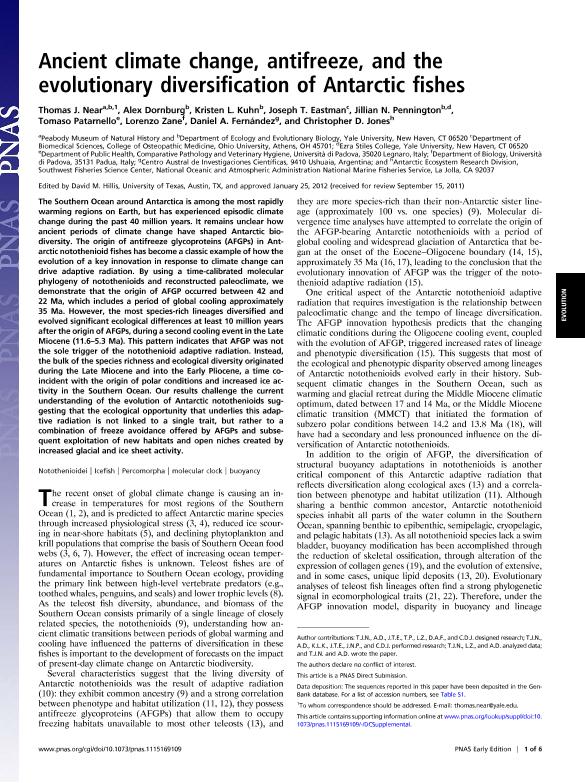Artículo
Ancient climate change, antifreeze, and the evolutionary diversification of Antarctic fishes
Near, Thomas; Dornburg, Alex; Kuhn, K.; Eastman,Joseph T.; Pennington, Jillian N.; Patarnello, Tomaso; Zane, Lorenzo; Fernandez, Daniel Alfredo ; Jones, Christopher D.
; Jones, Christopher D.
 ; Jones, Christopher D.
; Jones, Christopher D.
Fecha de publicación:
02/2012
Editorial:
National Academy of Sciences
Revista:
Proceedings of the National Academy of Sciences of The United States of America
ISSN:
0027-8424
Idioma:
Inglés
Tipo de recurso:
Artículo publicado
Clasificación temática:
Resumen
The Southern Ocean around Antarctica is among the most rapidly warming regions on Earth, but has experienced episodic climate change during the past 40 million years. It remains unclear how ancient periods of climate change have shaped Antarctic bio-diversity. The origin of antifreeze glycoproteins (AFGPs) in Antarctic notothenioid fishes has become a classic example of how the evolution of a key innovation in response to climate change can drive adaptive radiation. By using a time-calibrated molecular phylogeny of notothenioids and reconstructed paleoclimate, we demonstrate that the origin of AFGP occurred between 42 and 22 Ma, which includes a period of global cooling approximately 35 Ma. However, the most species-rich lineages diversified and evolved significant ecological differences at least 10 million years after the origin of AFGPs, during a second cooling event in the Late Miocene (11.6-5.3 Ma). This pattern indicates that AFGP was not the sole trigger of the notothenioid adaptive radiation. Instead, the bulk of the species richness and ecological diversity originated during the Late Miocene and into the Early Pliocene, a time co-incident with the origin of polar conditions and increased ice activity in the Southern Ocean. Our results challenge the current understanding of the evolution of Antarctic notothenioids suggesting that the ecological opportunity that underlies this adaptive radiation is not linked to a single trait, but rather to a combination of freeze avoidance offered by AFGPs and subsequent exploitation of new habitats and open niches created by increased glacial and ice sheet activity.
Palabras clave:
BUOYANCY
,
ICEFISH
,
MOLECULAR CLOCK
,
NOTOTHENIOIDEI
,
PERCOMORPHA
Archivos asociados
Licencia
Identificadores
Colecciones
Articulos(CADIC)
Articulos de CENTRO AUSTRAL DE INVESTIGACIONES CIENTIFICAS
Articulos de CENTRO AUSTRAL DE INVESTIGACIONES CIENTIFICAS
Citación
Near, Thomas; Dornburg, Alex; Kuhn, K.; Eastman,Joseph T.; Pennington, Jillian N.; et al.; Ancient climate change, antifreeze, and the evolutionary diversification of Antarctic fishes; National Academy of Sciences; Proceedings of the National Academy of Sciences of The United States of America; 109; 9; 2-2012; 3434-3439
Compartir
Altmétricas



